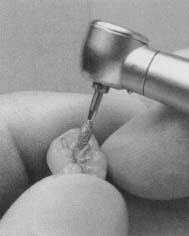Dental drill
When a tooth develops a cavity, the decayed tissue must be removed. The earliest devices for doing this were picks and enamel scissors. Later, two-edged cutting instruments were designed that were twirled in both directions between the fingers. The father of modern dentistry, Frenchman Pierre Fauchard (1678-1761), described an improved drill in 1728. Its rotary (turning around a central point) movement was powered by catgut twisted around a cylinder, or by jewelers' bowstrings. A hand-cranked dental drill bit was patented by John Lewis in 1838. George Washington's dentist, John Greenwood (1760-1819), invented the first known "dental foot engine" in 1790. Greenwood adapted his mother's foot-treadle (pedal) spinning wheel to rotate a drill. Greenwood's dentist son continued to use the drill, but the idea went no further.

Early Drill Designs
Scottish inventor James Nasmyth used a coiled wire spring to drive a drill in 1829. Charles Merry of St. Louis, Missouri, adapted Nasmyth's drill by adding a flexible cable to it in 1858. The first motor-driven drill appeared in 1864, the design of Englishman George F. Harrington. This "motor drill" was a hand-held device powered by the spring action of a clock movement. In 1868 American George F. Green introduced a pneumatic (air-driven) drill powered by a pedal bellows. Fellow American James B. Morrison patented a pedal bur drill in 1871. A further improvement of the Nasmyth-Merry design, the bur drill featured a flexible arm with a handpiece to hold the drill, a foot treadle, and pulleys. Each of these developments increased the speed at which the drill operated.
In 1874, six years after he made his original contribution to drills, Green added electricity to the dental drill. Green's drill was powered by electromagnetic motors and worked well, but it was also heavy and expensive. Plug-in electric drills became available in 1908. By that time, most dental offices had electricity.
The Modern Dental Drill
Once efficient, mechanically-driven drills became widely available, teeth could be properly and accurately prepared for well-fitting crowns (an artificial substitute for the part of the tooth projecting beyond the gum line) and fillings. American teeth blossomed with the gold of inlays (a filling for a tooth made from a mold) and crowns. Modern dental drills are turbine-powered and rotate at speeds of 300,000 to 400,000 revolutions per minute. Drills generate a large amount of heat but are less irritating to the patient because the cutting action is smoother.
[See also Dental fillings, crown, and bridge ]